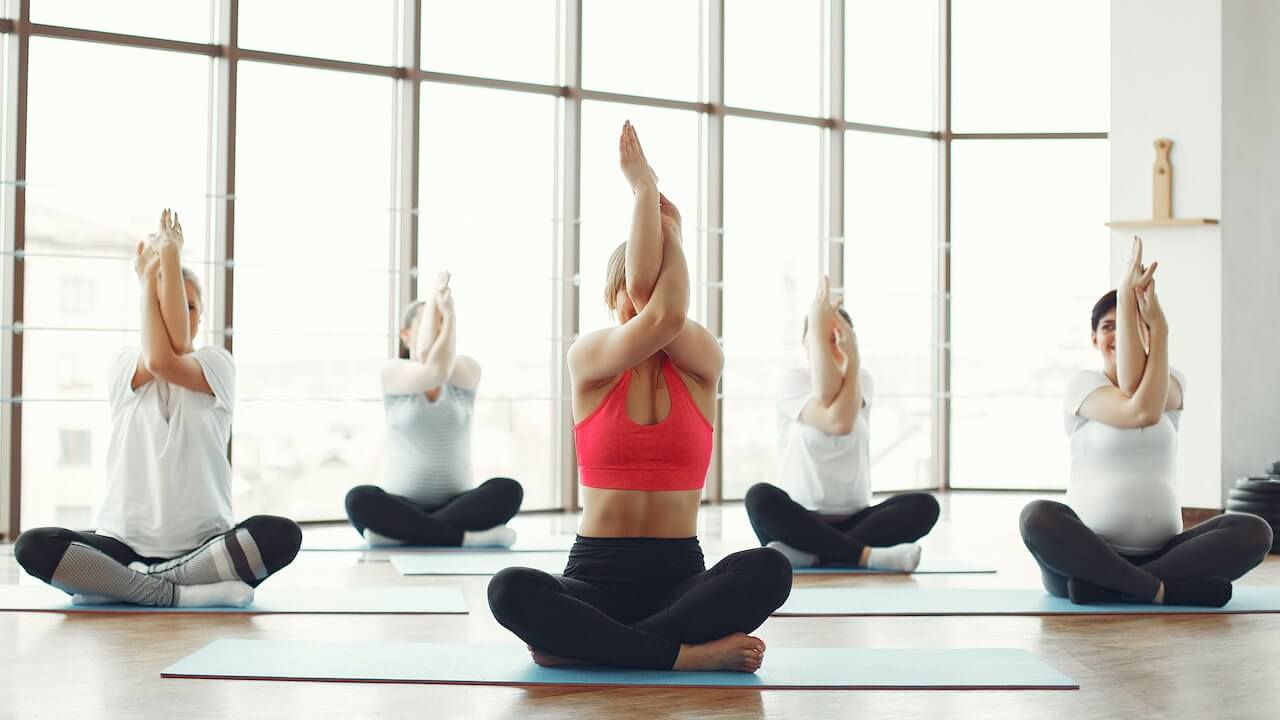Yoga is a great way for beginners to gradually build strength, flexibility, and mindfulness. With its gentle movements and focus on breath, it’s the perfect way to ease into a fitness routine that can be sustained for life. One of the best things about yoga is that it can be practiced at any level of intensity, making it accessible to anyone regardless of their age or physical ability.
For those who are new to yoga, there are several key practices that are particularly helpful in building strength and flexibility while also calming the mind. These include basic poses like downward dog, warrior I and II, and tree pose. Additionally, incorporating breathing techniques such as ujjayi breath (also known as ocean-sounding breath) can help deepen relaxation and focus during your practice.
Another important aspect of yoga for beginners is finding a teacher or class that feels supportive and welcoming. Many studios offer beginner-friendly classes with instructors who specialize in helping students modify poses or adjust their alignment as needed. By taking the time to explore different styles of yoga and find an instructor who resonates with you personally, you’ll be able to develop a consistent practice that supports your overall health and well-being over time.
Finding the Right Yoga Style:
When it comes to finding the right yoga style, beginners may feel overwhelmed by the many options available. It is essential to consider your goals, body type, and personality to land on a yoga practice that suits you best. For instance, if you are looking for a gentle practice that emphasizes relaxation and flexibility, restorative yoga or yin yoga might be the ideal choice.
On the other hand, if you want to build strength and sweat it out while still enjoying the benefits of mindfulness meditation, power or hot yoga could be more appropriate. Also important to consider is whether you prefer a structured or free-form class format; some styles have set poses and sequences (such as Ashtanga), while others allow for creative flow (like Vinyasa). In any case, take time to research various styles and attend classes with different instructors until you find one that feels like home.
Remember that there is no such thing as a “right” style of yoga – what works for one person may not resonate with another. The beauty of this ancient practice lies in its versatility: there are endless variations on traditional poses and techniques that can accommodate any level of experience or preference. Ultimately, finding the right yoga style involves listening to your body’s needs and honoring them with patience and compassion.
Choosing the Best Practice for You
When it comes to choosing the best yoga practice for you, it’s important to consider your own needs and goals. If you’re a beginner, you may want to start with a gentle Hatha or Yin yoga class that focuses on stretching and relaxation. These practices are great for improving flexibility and reducing stress.
On the other hand, if you’re looking for a more intense workout, Vinyasa or Power Yoga may be better suited for you. These practices involve flowing through poses at a faster pace and can help build strength. It’s important to remember that while these classes can be challenging, modifications are always available for beginners.
Ultimately, the best practice for you is one that feels good in your body and aligns with your personal goals. Don’t be afraid to try different styles of yoga until you find what works best for you. And remember, yoga is not about perfection – it’s about showing up on your mat and doing what feels right in the moment.
The Essential Poses:
When starting out with yoga, it can be overwhelming to know which poses to focus on. However, there are a few essential poses that every beginner should learn in order to build a strong foundation for their practice. One of these essential poses is downward-facing dog, which helps to stretch the entire body and build strength in the arms and shoulders.
Another important pose for beginners is Warrior II, which strengthens the legs and opens up the hips. This pose also helps to improve balance and stability. Additionally, the cat-cow pose is a great way to warm up the spine and improve flexibility in the back.
While there are many other yoga poses that can be beneficial for beginners, focusing on these three essential poses will provide a solid foundation for any new practitioner. As you become more comfortable with these foundational postures, you can begin exploring different variations and more advanced poses at your own pace.
Building a Foundation for Your Practice
When beginning a yoga practice, it’s important to start by building a strong foundation. This means taking the time to learn proper alignment in basic poses and focusing on breath control.
One way to build this foundation is by attending beginner-friendly classes and workshops. These classes will often focus on breaking down each pose and providing modifications for those who may need them.
In addition to attending classes, it’s also important to establish a consistent home practice. This can be as simple as setting aside 10-15 minutes each day to practice basic poses or follow along with an online tutorial. By establishing a regular routine, you’ll not only improve your physical strength and flexibility but also develop mental clarity and focus.
Creating a Routine:
Creating a routine is an essential aspect of starting your yoga practice as a beginner. It helps you stay consistent, focused and motivated in your journey. The first step to creating a routine is to set achievable goals that align with your lifestyle and schedule. You can start by setting aside 10-15 minutes for daily practice and gradually increase the time as you become more comfortable.
Secondly, choose a specific time and place for your practice every day. This will help you develop discipline and make it easier to stick to your routine. It’s important to create an environment that supports your practice, such as clearing out clutter or lighting candles to create a calming atmosphere.
Lastly, mix up your routine by trying different styles of yoga, incorporating meditation or pranayama (breathing exercises). This will keep things interesting while allowing you to explore different aspects of the practice. Remember that creating a routine takes time and patience, so be kind to yourself along the way. With consistency and dedication, you’ll reap the benefits of this transformative practice in no time!
Establishing a Consistent Yoga Practice
1. Start small and set achievable goals. If you’re new to yoga, don’t expect to do a full hour-long practice right away. Instead, start with 10-15 minutes of practice each day and gradually increase the duration as you become more comfortable.
2. Create a routine that works for you. Whether it’s in the morning before work or in the evening before bed, establish a consistent time and place for your yoga practice so that it becomes part of your daily routine.
3. Find a style of yoga that resonates with you. There are many different styles of yoga, from gentle restorative practices to more vigorous vinyasa flows. Experiment with different styles until you find one that feels enjoyable and sustainable for you.
4. Use props when necessary. Don’t be afraid to use props such as blocks, straps, or blankets if they help make certain poses more accessible or comfortable.
5. Practice mindfulness during your yoga sessions by focusing on your breath and being present in the moment rather than letting your mind wander.
6. Be patient with yourself – progress takes time! Remember that everyone’s journey is unique and there is no “right” way to do yoga; all that matters is that you show up on the mat consistently and listen to your body’s needs along the way.
7. Seek out guidance from experienced teachers or online resources if needed to help deepen your understanding of alignment, breathing techniques, or other aspects of practicing yoga safely and effectively.
Tips for Success:
1. Start Slowly: As a beginner, it’s important to start slow and focus on mastering the basics before moving on to more advanced yoga poses. This will help prevent injury and build a strong foundation for your practice.
2. Find a Good Teacher: Finding a good teacher who can guide you through proper alignment and technique is crucial for success in yoga. Look for someone with experience teaching beginners and who makes you feel comfortable and supported in your practice.
3. Practice Regularly: Consistency is key when it comes to building strength, flexibility, and overall progress in your yoga practice. Aim to practice at least 2-3 times per week, even if it’s just for 10-15 minutes at a time.
4. Listen to Your Body: It’s important to listen to your body during yoga practice and honor its limitations. Don’t push yourself too hard or force yourself into poses that feel uncomfortable or painful.
5. Focus on Breath: The breath is an essential component of yoga practice that can help calm the mind, reduce stress, and improve overall wellbeing. Pay attention to your breath throughout your practice, focusing on deep inhales and exhales.
6. Use Props as Needed: Props such as blocks, straps, blankets, or bolsters can be helpful tools for beginners who may not have the flexibility or strength needed for certain poses yet.
7. Be Patient with Yourself: Remember that progress takes time in any new endeavor – including yoga!
How to Make Each Practice Count
1. Set specific goals for each practice: Before starting your yoga practice, set some goals that you want to achieve in that session. It can be as simple as focusing on your breath or perfecting a particular pose. Having a set goal will keep you motivated and help you make the most of your time on the mat.
2. Warm-up properly: Warming up before any physical activity is crucial to avoid injuries and prepare your body for the practice ahead. Start with some gentle stretches and movements to loosen up your muscles, increase blood flow, and improve flexibility.
3. Pay attention to alignment: Proper alignment is essential in yoga as it helps prevent injury and enhances the benefits of each pose. Listen carefully to the teacher’s instructions, use props if necessary, and take time to adjust yourself until you feel comfortable in each posture.
4. Focus on breathing: Breathwork (pranayama) is an integral part of yoga practice as it helps calm the mind, reduce stress levels, and improve concentration. Try synchronizing your breath with movement or practicing deep breathing exercises like ujjayi pranayama or alternate nostril breathing.
5. End with relaxation: Savasana (corpse pose) is usually done at the end of every yoga class to allow the body and mind to relax completely after all the hard work put into the practice. Don’t skip this important step!
Benefits Beyond the Mat:
The benefits of yoga extend beyond the physical practice on the mat. Yoga can have a profound impact on one’s mental and emotional well-being, making it a holistic practice for overall health. Regular yoga practice has been shown to reduce stress and anxiety levels, improve sleep quality, boost mood and cognitive function, increase self-awareness and mindfulness, and promote a sense of inner peace.
Additionally, yoga philosophy teaches valuable lessons about acceptance, non-judgment, gratitude, and compassion that can be applied in everyday life. The cultivation of these qualities through yoga can lead to better relationships with oneself and others. Furthermore, many people find that their spiritual connection is strengthened through regular yoga practice.
Overall, incorporating yoga into one’s lifestyle has numerous benefits beyond just physical fitness. It can be a transformative practice for mental and emotional health as well as personal growth.
The Impact of Yoga on Your Life
Yoga is a transformative practice that can have a profound impact on your life. It has been proven to reduce stress and anxiety, improve flexibility and balance, increase strength, and promote overall physical and mental well-being. Through the regular practice of yoga, you can experience a greater sense of calmness, clarity, and focus in your daily life.
The benefits of yoga extend beyond just the physical body. Yoga also cultivates mindfulness and self-awareness by helping you connect more deeply with yourself on both a mental and emotional level. You will learn to listen to your body’s needs and respond with kindness and compassion. Over time, this practice can help you develop greater resilience in the face of life’s challenges.
In addition to its many health benefits, yoga can also be a source of community connection as you meet other like-minded individuals who share your passion for wellness. Whether you are looking for stress relief or simply want to improve your physical fitness, incorporating yoga into your daily routine is an excellent way to enhance your overall quality of life.
Conclusion:
In conclusion, yoga is an ancient practice that has been used for centuries to improve physical and mental health. As a beginner, it can be overwhelming to start a yoga practice, but with the right guidance and patience, anyone can begin their journey towards a healthier lifestyle. Starting with basic poses and gradually increasing difficulty level is the key to success in yoga.
Remembering to breathe deeply and mindfully during each pose helps maintain focus and balance throughout the practice. Consistency in practicing yoga is also important for long-term benefits such as increased flexibility, reduced stress levels, improved immune system function and better sleep quality.
Incorporating these best practices into your daily routine will greatly improve your overall well-being. So take your time, listen to your body and enjoy the process of discovering yourself through yoga!
Start Your Journey Today with These Best Practices
The practice of yoga has become increasingly popular in recent years, with many people seeking its physical and mental benefits. For beginners who are just starting their journey, it can be overwhelming to understand where to begin. However, there are several best practices that can help individuals make progress in their yoga practice while avoiding injury.
One important best practice is to start slow and listen to your body. It’s crucial not to overdo it or push yourself too hard too quickly. Instead, focus on building a strong foundation by mastering basic poses before moving onto more advanced ones. Additionally, proper alignment is essential for preventing injuries and getting the most out of each pose.
Another critical best practice for beginners is consistency. Yoga is a discipline that requires regular practice for optimal results. Even if you only have a few minutes each day, try to establish a routine that works for you and stick with it as much as possible.
Finally, finding a qualified instructor or attending group classes can also be beneficial for beginner yogis. Having an experienced teacher guide you through proper form and technique can improve your understanding of the practice while helping you avoid common mistakes that could lead to injury or frustration.
By following these best practices and remaining patient with yourself throughout the process, anyone can incorporate yoga into their daily life and begin reaping its numerous benefits today!



